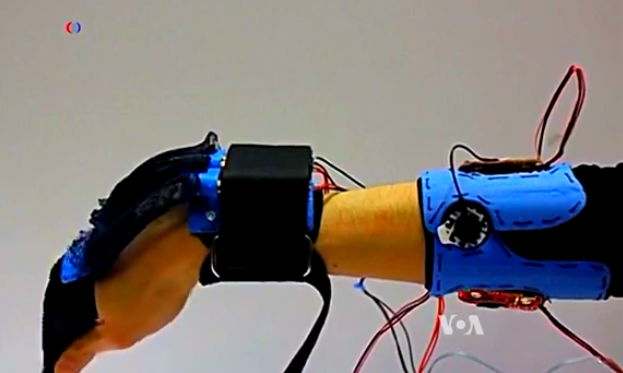This device called Vigor supports and boosts the child's movement. The device has complex sensors that detect movement and send information to a set of flexible cables powered by actuators that provide automatic support for weak muscles.
这套装置名字叫做Vigor,它可以支持并促进孩子进行运动。该装置拥有复杂的传感器,能够探测运动,并向一组由制动器驱动的柔性电缆发送信息,从而为力量不足的肌肉提供自动化支持。
"What the user needs to do is just need a little bit force with the device. The device will provide extra strength on the muscle to help the children complete the movement."
"在使用设备时,用户所需要做的就是动用少许力量。然后该设备就会为肌肉提供额外的力量,以帮助儿童完成这一动作。"
Xinyang Tan is a graduate student at the Royal College of Art. He knows what it's like to have weak muscles because he was born with cerebral palsy.
谭新阳是伦敦皇家艺术学院的一名研究生,他知道肌肉无力是什么样的感受,因为自己出生时就患有脑瘫。

He hopes his device will make easier for children with muscular diseases to do things like eat and move a computer mouse.
他希望自己设计的装置可以使罹患肌肉疾病的儿童在做一些事情时更加轻松,比如吃东西或者滚动鼠标。
"They actually exercise the muscles they already have, so become stronger and extend the period of mobility of their limbs."
"他们实际上是在锻炼自己本身就具有的肌肉,这样肌肉就会变得更加强壮,还可以延长四肢移动的时间。"
Tan says there are other devices available for children with cerebral palsy or muscular dystrophy. But Vigor is the first mechanism that allows for movement of the joints.
谭新阳表示,针对患有脑瘫和肌肉萎缩症的儿童,市面上也可以找到其他装置来帮助他们完成各项运动,不过Vigor却是第一套允许关节活动的装置。
"You can fully control it as a normal people."
"你完全可以像正常人一样来控制它。"
Tan has started a business for Vigor and plans to market it once he's perfected the apparatus.
谭新阳如今已经为Vigor创办了一家公司,设备一经完善,他就打算在市场上进行出售。













